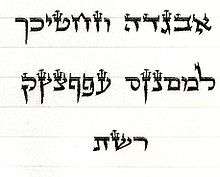Ashuri alphabet
Ashuri alphabet (Hebrew: אָלֶף־בֵּית אַשּׁוּרִי, álef-bet ashurí) means Assyrian alphabet and also refers to the Assyrian script (Hebrew: כְּתָב אַשּׁוּרִי, ktav ashurí) which is the name for a traditional calligraphic form of the Aramaic alphabet, and a term that was first used in the Mishnah to refer to either the Aramaic alphabet or the formal script used in certain Jewish ceremonial items, including Sefer Torah, Tefillin, Mezuzah also abbreviated as STA"M[1] (Hebrew: סת"ם). It is also referred to as the "square" script. This is the Aramaic script that replaced the original ancient Hebrew alphabet, becoming the modern Hebrew alphabet.

There are many rules concerning the proper formation of letters if the written text is to be valid for religious purposes.
The Ashkenazi, Sephardi, Chabad (Lubavitch), and Mizrahi (Middle-Eastern Jews) each have their own calligraphic tradition in the method by which each letter is formed, however the final shape of each letter conforms to the legal standard regardless of the calligrapher. While the shapes of the letters are the same, styles can be quite different. Generally, while each tradition favors their own calligraphic style as preferable, none consider the tradition of the other passul (invalid) for Sifrei Torah (Torah scrolls) or any other ritually used scroll or parchment.
Yemenite tradition also has its own tradition, slightly different.